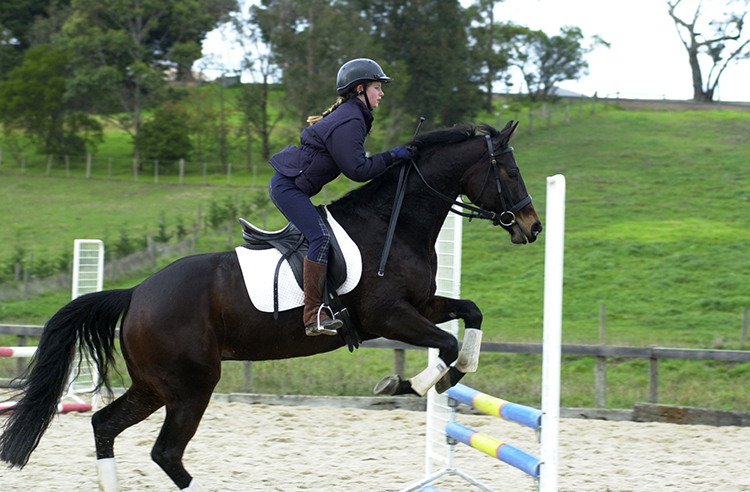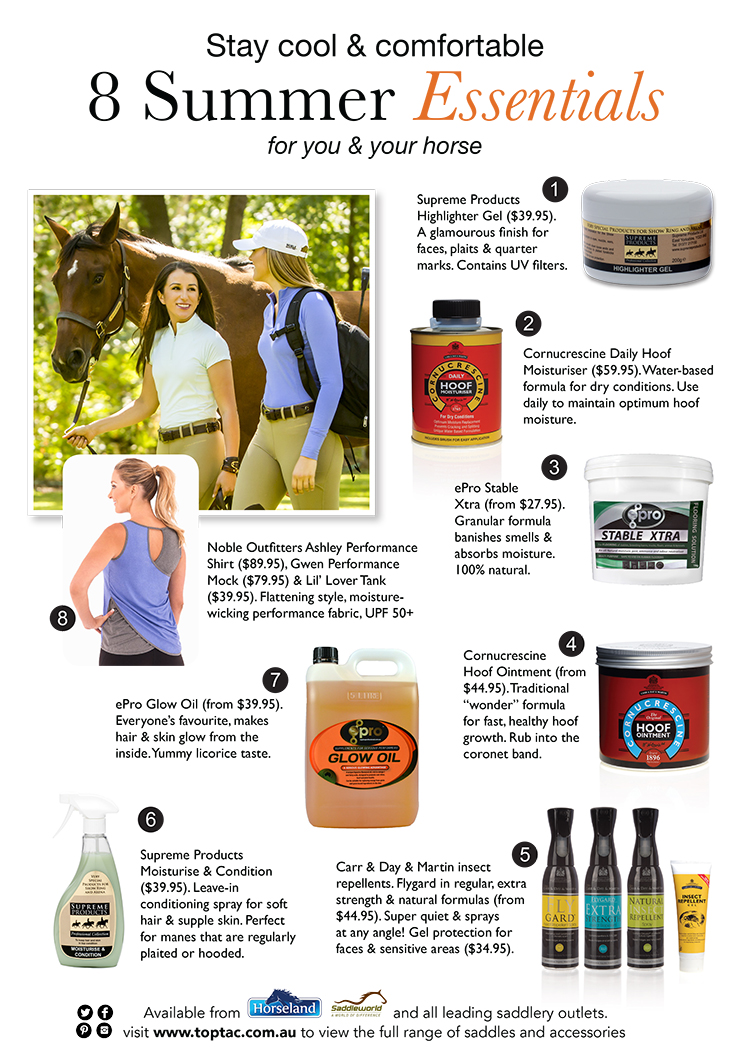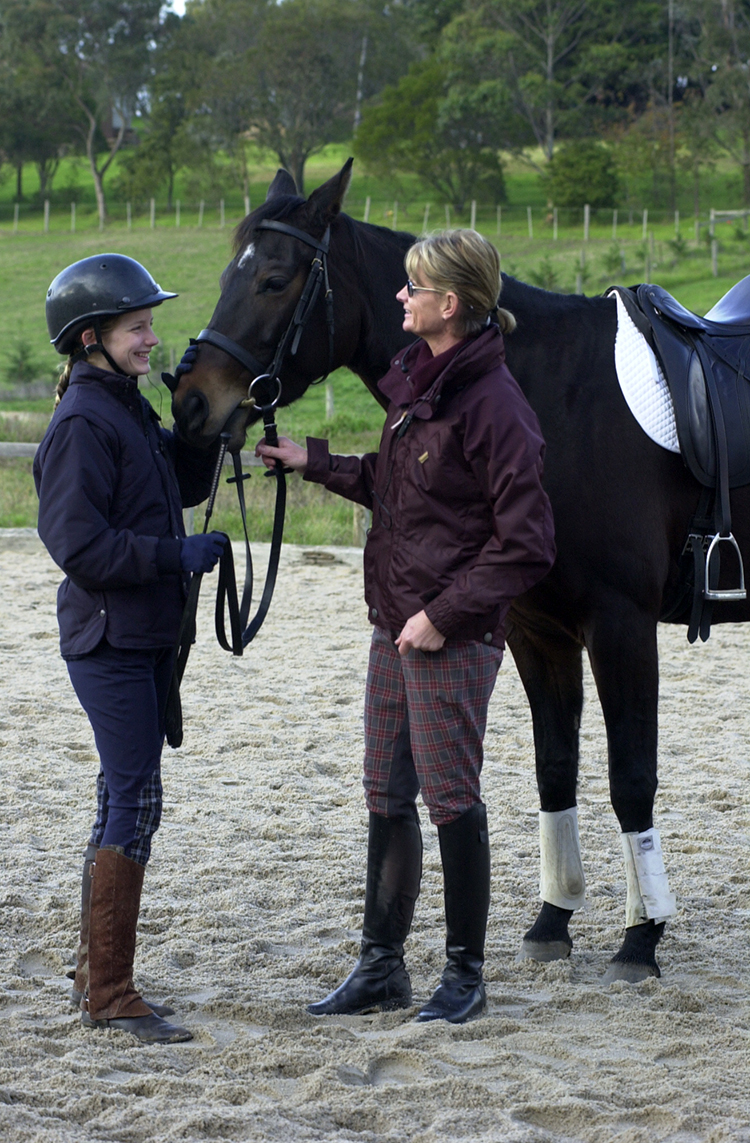 Our favourite young horse, Winsome has just come back into work after some time off. She is back with 14-year-old Laura Rowe in the saddle, and coach Michelle Strapp on the ground…
Our favourite young horse, Winsome has just come back into work after some time off. She is back with 14-year-old Laura Rowe in the saddle, and coach Michelle Strapp on the ground…
Words by Chris Hector and photos by Roz Neave
Michelle easing Winnie back into work: “In the past three months, she has had time out with a foot abscess, and Laura has only just brought her back in. We’ve had a couple of jumping sessions, and my policy with young horses and jumping sessions is to keep the warm up short. Ten minutes of canter is fine, then start the jumping- then if you hit a flatwork issue while you are jumping, there is plenty of time to come back to that. If you spend half an hour on the flat before they start jumping, then by the time you start, the horse is fatigued. So what we are going to do today is a ten minute warm up, some small jumping exercises, then build up to a little course.”
And of course, like horses usually do when they come back from a break, Winnie is going brilliantly. Her movement is becoming more extravagant all the time, and Laura is just riding her beautifully.
Michelle is using head phones in this training session, and loves the added sophistication this gives her in her communication with the pupil: “l find that with head phones you can add so much more to your teaching because you can pick it up straight away when something is happening. If something is happening right at the other end of the arena, and you can say ‘do you feel what is happening now’ it is within the moment that the rider can feel. There is black and white in riding, but there is a lot of feel involved. Without the head phones they tend to turn to try and listen to you, the student is actually focussing more on your voice, trying to hear you – and they forget to concentrate on the horse.”
(Article continues below)
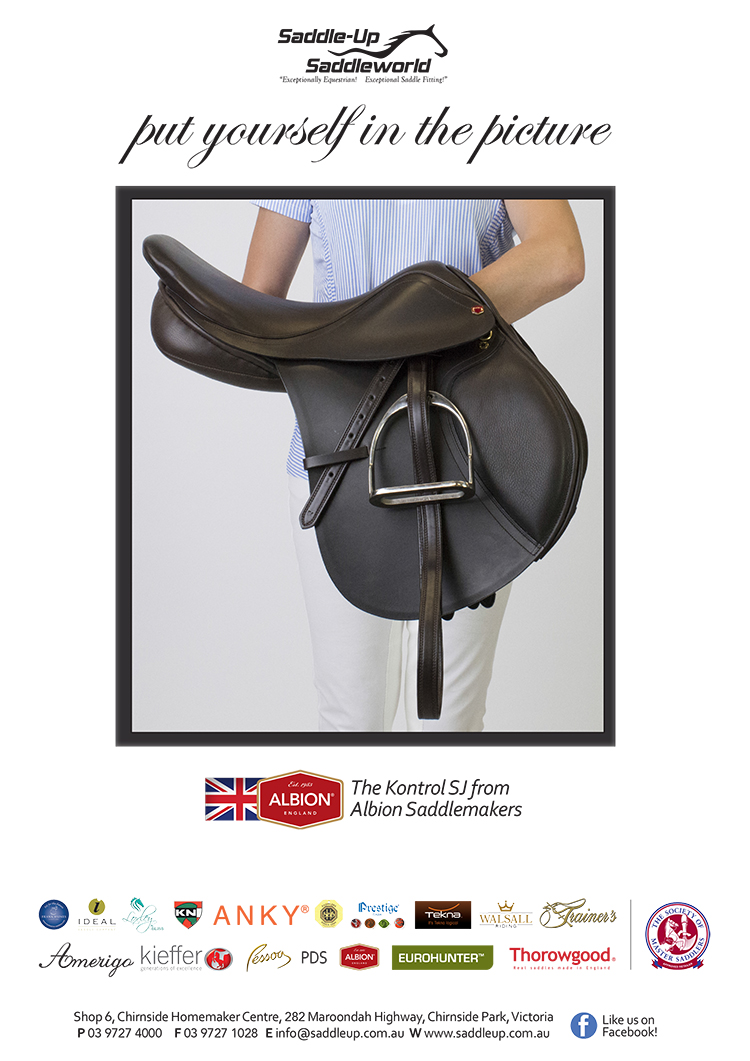
Laura and Winnie are not only going brilliantly on the flat, but they are getting better and better over the jumps.
“Before she had Winnie, Laura had only ever done grade five pony club, all she learnt with the pony she had was basic things like ‘keep your eyes up’, to know what lead you land on, heels down and releases. The beauty now we are moving on to this level, is that we can concentrate on the feel of Winnie’s canter, the quality of the canter, what sort of canter produces what sort of jump – and related distances. I shouldn’t have to keep coming back to, ‘your eyes are down’. That should be automatic now.
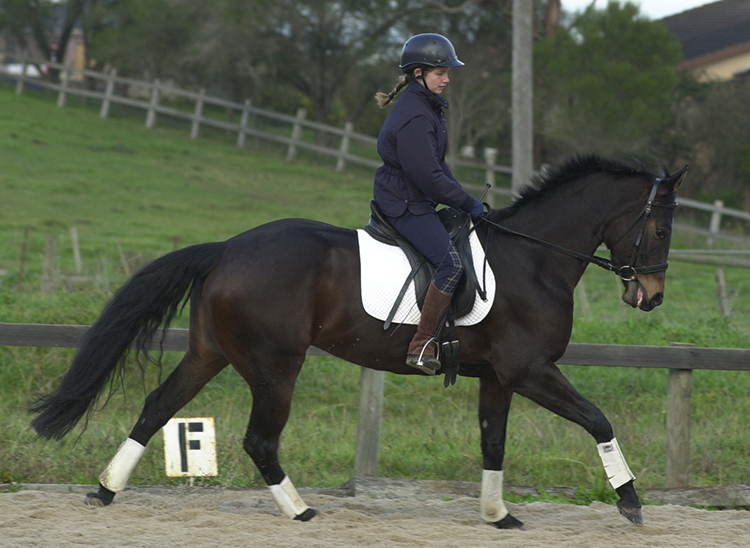
Laura’s got to learn to ride a few fences and get a feeling of whether it is long or short. She is starting to get that feeling, those good instincts, things are starting to become a little more automatic. It’s a big step for someone who has come off a pony to be educating a four year old. The horse is unique in that it has got an amazing temperament; the horse is very predictable. What I am finding is that the horse is becoming more consistent, and what Laura is doing as a rider is that she is starting to read what is going wrong.”
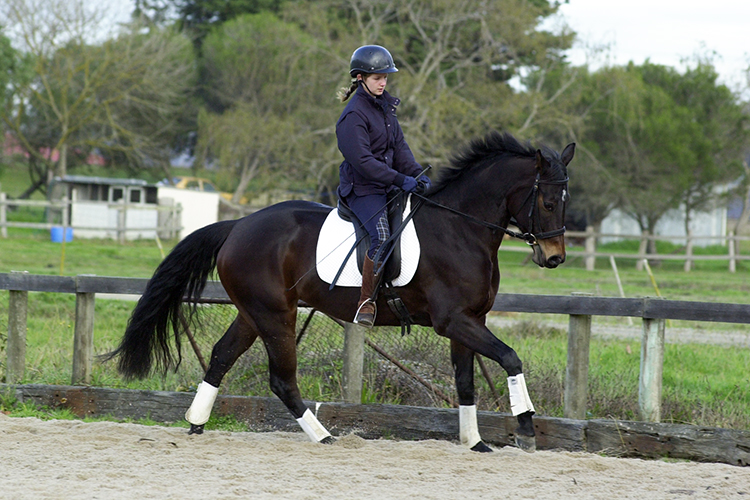
“That’s crucial with a younger horse. You might say, today we want to do some slower work- but if you get on and the horse is curling itself up, then your instinct should say, no we do some more forward work first. I think Laura is starting to read that and so is going to help the ongoing training of the horse.”
Laura’s warm up was great, with the mare just showing a slight tendency to come behind the aids. This is hardly surprising since even the professional riders in Australia seem to have a problem understanding the concept of the horse being in front of leg, Michelle thought this was accentuated by Laura’s perfectionist temperament:
“It is so easy for Laura to get caught up with making it perfect, and forget there is a ‘go’ button. That is the beauty of the training set ups in Europe where they have the riding tracks, and instead of taking the horses straight into a little arena they get them out and going first. This mare has a little bit of a habit of saying, ‘I’ll just go into a rocking horse canter’ and not go forward – so I always try to get Laura and Winnie positive and forward, even before they jump a fence. I’m really glad now that Laura has the feeling to hold her straight and get her even into both hands.”
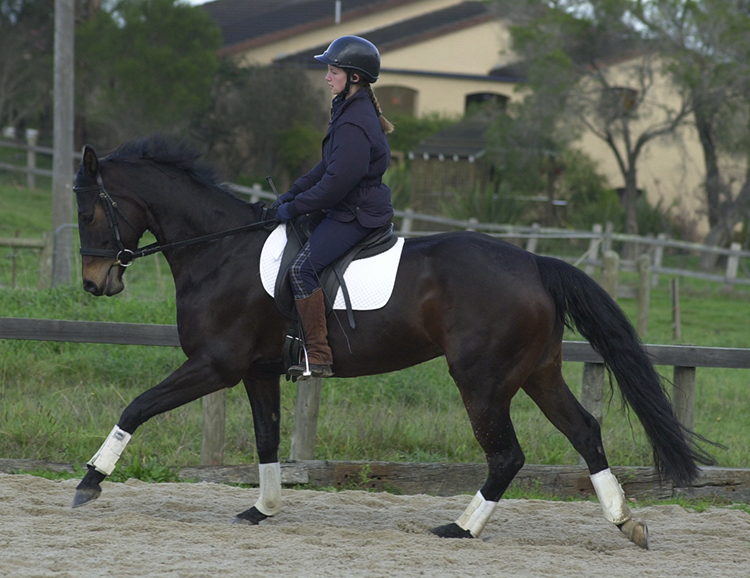
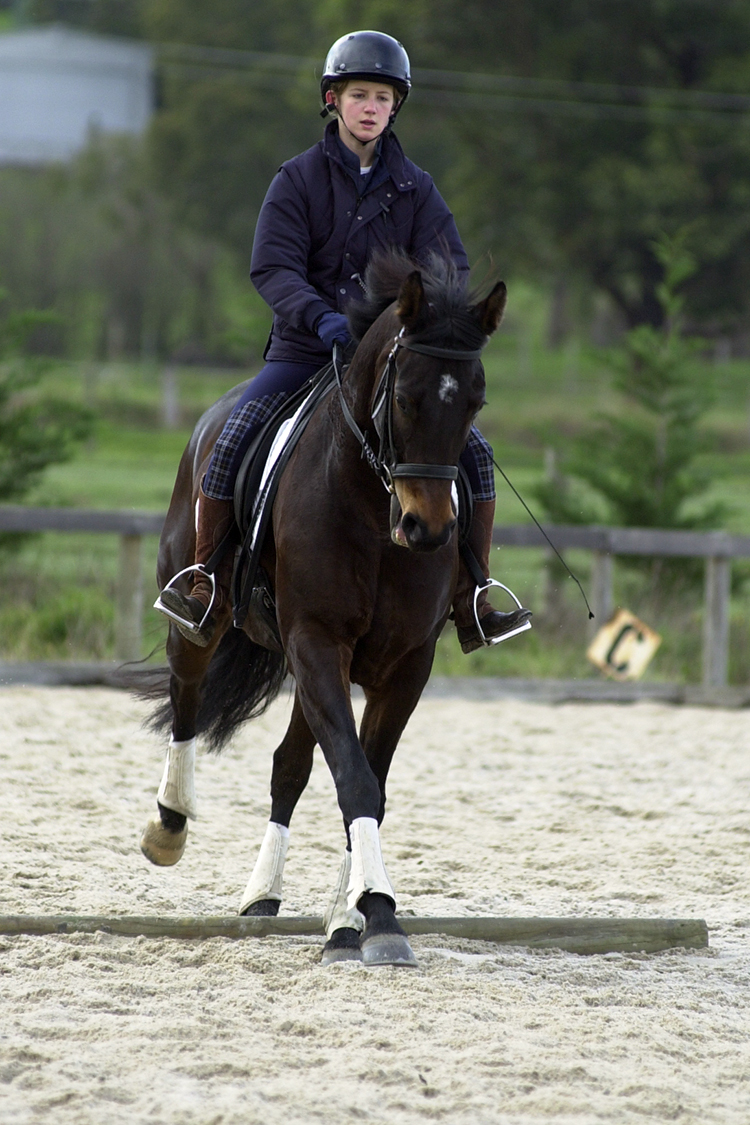
Of course we once again realise how different Michelle is when it comes to jumping training, since most jumping riders rely on the jumps to create the forward…
“Jumps create energy but I want Laura to get the feeling of having Winnie in front of her leg. That takes time. You can see sometimes when she is cantering around that she is working too hard with her upper body. This horse is not really in front of the leg yet, because Laura hasn’t quite grasped the feel of it. It is hard for her to close the canter up correctly because the mare just sucks from behind her, instead of going BIGGER but SLOWER. What I often do in the warm up, is to get Laura to change the angles with her upper body. As she changes her angle, nothing about the way the horse goes, should change. Because most horses are not in front of the leg, when the rider changes the angle of their body, the horse will fall to a trot, or lose its balance in the canter. It’s a good test generally for any horse, but it’s more important for jumping riders, because when we land from a fence, we are in a light seat. We don’t have the seat there pumping to keep the canter going. Again I learnt that from George Morris – he once asked me if I was doing a disco dance on the horse’s back!”
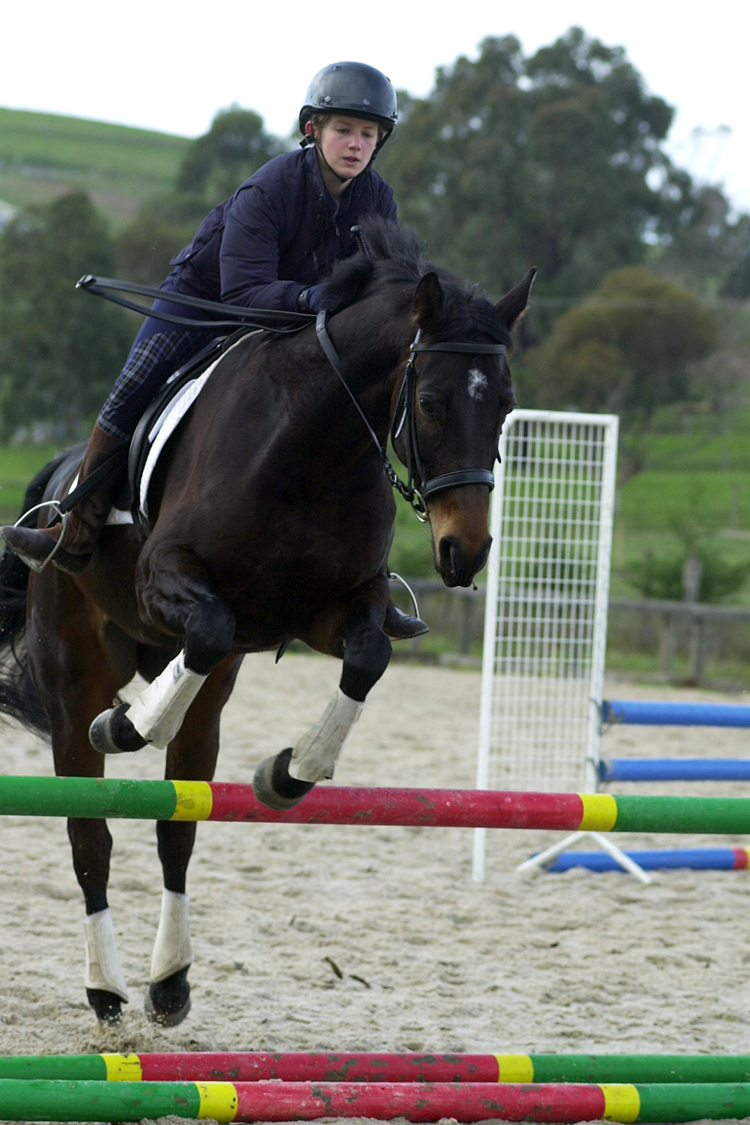
Crunch – Winnie gets it wrong and scatters the poles…
And as Laura starts working over the little jumps, Michelle slips into her coach mode: “Keep the elbows soft and elastic, tr…av…el beau-ti-ful, good girl, sit up, eyes the next fence. Now we are coming into the combination, it’s a spooky little fence, test your canter, test she is in front of your leg, float down…”
It all goes wrong, but Laura keeps her cool: “That’s the jockey sitting cold. You had a beautiful open option and you sat cold, you were trying to be too perfect. Ride forward, now canter, work the canter, keep changing the gears. Now we’ll come back to walk. What were you thinking two strides in front of that combination? It’s a combination you shouldn’t even be thinking short. You had a canter to suit an open option, and especially with a baby horse at a combination that was the way to go.”
Laura does it again, but this time the canter is a little to lacking for Michelle’s taste:
“A bit of a negative distance came up, because the canter was going into that little lolly canter. As soon as you land from a fence, make sure you get the canter back in front of your leg, keep testing it the whole time.”
“At the moment you are not experienced enough to read the canter so you get caught out. You’ve got to learn from that.”
But next time is looking good!
(Article continues below)
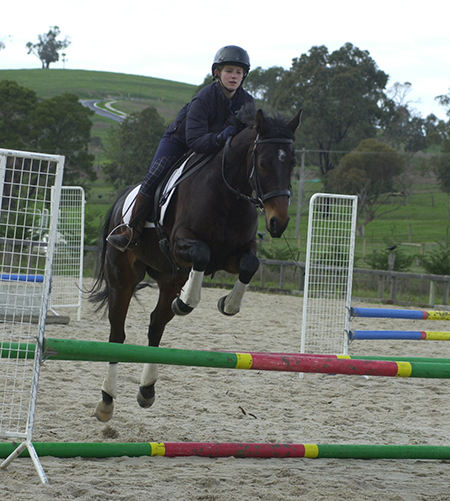
Winnie has learnt from her encounter with the woodwork, she is tucking her little legs up neatly now.
“That’s why you get juniors to ride your horse,” quips Michelle, “get them back and they are beautiful. The lovely thing about a young rider like Laura is that she doesn’t hinder the horse. Even though she has made a distance error, she is not pulling her in the mouth, she’s not making her crooked, she is not altering her rhythm.”
And the pair have got it back again, really a beautiful canter, and Laura sitting so sweetly.
“Lovely that time, you sat very nicely and gave her plenty of rein AND you made a choice – and it was the right decision. That little cluck was right.”
We are back working on the quality of the canter: “Really big, bigger, open her up, now sit her up a bit, think of just waiting with your body, sit her up, but with very little hand. Sit her up, then soft, short release, good now you are changing your upper body angles. You should have at least 20 upper body angles. At the moment when Laura changes her body angles she is a little bit stiff in the hips. When she goes a little light, it doesn’t look as natural through the hips, and that is only because she hasn’t done enough of it. She is thinking ‘oh my canter is going to go’ and getting tight in the hips, and a little hollow in the back. The rider feels when they go in light seat that they have to push, it’s just a matter of getting the feeling right.”
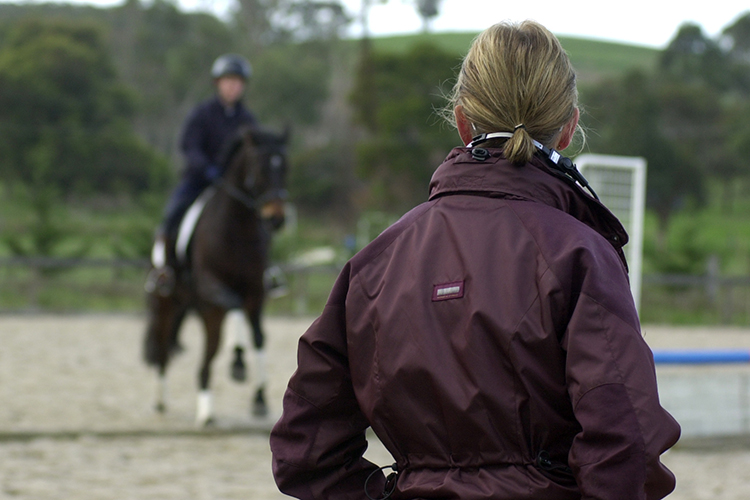
Back to the walk – but it still has to be a forward transition!
So it was time to come back to the walk, but once again, Michelle never has easy options, if the downward transition isn’t forward, then you have to do it again.
“Trot out. Activate it, activate it. Big trot. Get your reins a little shorter, so that from your arm to your elbow to your hand to the bit, is one continuous contact, not a broken line. Now shorter, now hind leg, now come out of it, now shorter again, she is getting more and more bend in the joint. That’s great. Then when you come back to the walk, make her take you forward in the walk.”
At which point Michelle turned to me and asked, why don’t jumping riders do this stuff? I replied that last time I looked, Ludger Beerbaum did lots and lots of very similar stuff.
“So why do I feel like an alien… ”
I guess when Michelle no longer feels that her emphasis on quality flat work makes her some kind of freak, more Australians will be riding like Ludger…
“Give her a walk, give her a pat, that was good. There is quite a jump in the horse, but if you start sticking up the jumps, and Laura makes incorrect decisions, then the mare is going to say ‘forget it’. But at this height, she makes a little error, the mare is confident enough, that we get a good reaction. See Winnie didn’t get tight after that mistake, she stayed soft but thought about her technique. Now that Winnie is back in work it is a matter of Laura starting to jump lots of these fences. Remember the first day when we asked Laura if she was long or short, she was saying not sure, now she is starting to make the right decisions. What makes it so easy for me as a teacher is that she understands when she makes a mistake, how to fix it. If someone comes and they have no canter, they have a crooked horse, its head is up in the air, they come round the corner and they don’t know if they are long or short – how do you teach them? You’d have to take them back and teach canter before they can understand long or short, there’s no foundation to come back to.”
“Look at how straight Laura has Winnie when she comes to a fence. Laura is really keeping her in the chute, she is aware that the mare likes to travel a little to the right. They understand the language. The pair of them could go straight into a George Morris clinic because there is something there for him to build on.”
This article first appeared in the September 2003 issue of THM.
